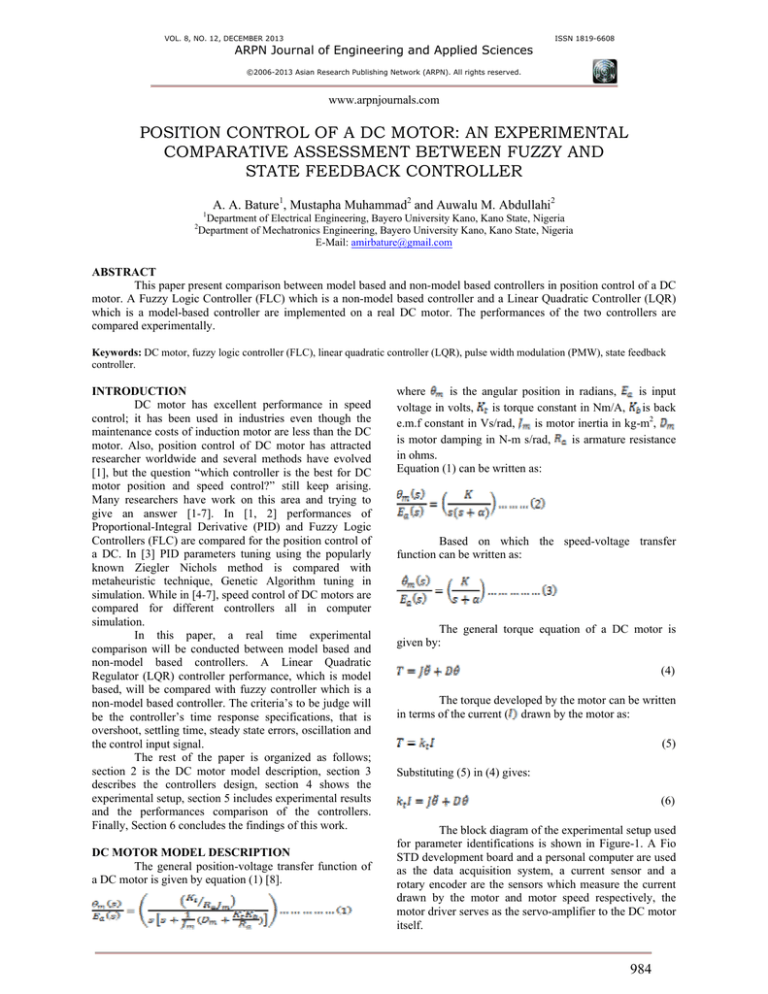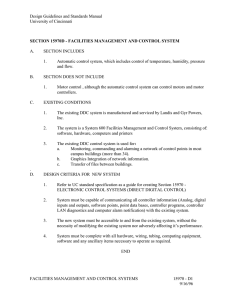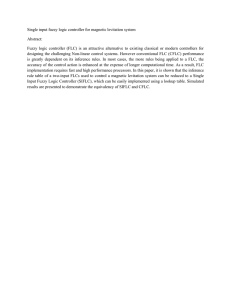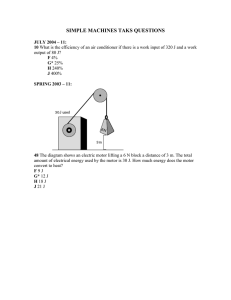
VOL. 8, NO. 12, DECEMBER 2013
ISSN 1819-6608
ARPN Journal of Engineering and Applied Sciences
©2006-2013 Asian Research Publishing Network (ARPN). All rights reserved.
www.arpnjournals.com
POSITION CONTROL OF A DC MOTOR: AN EXPERIMENTAL
COMPARATIVE ASSESSMENT BETWEEN FUZZY AND
STATE FEEDBACK CONTROLLER
A. A. Bature1, Mustapha Muhammad2 and Auwalu M. Abdullahi2
1
Department of Electrical Engineering, Bayero University Kano, Kano State, Nigeria
Department of Mechatronics Engineering, Bayero University Kano, Kano State, Nigeria
E-Mail: amirbature@gmail.com
2
ABSTRACT
This paper present comparison between model based and non-model based controllers in position control of a DC
motor. A Fuzzy Logic Controller (FLC) which is a non-model based controller and a Linear Quadratic Controller (LQR)
which is a model-based controller are implemented on a real DC motor. The performances of the two controllers are
compared experimentally.
Keywords: DC motor, fuzzy logic controller (FLC), linear quadratic controller (LQR), pulse width modulation (PMW), state feedback
controller.
INTRODUCTION
DC motor has excellent performance in speed
control; it has been used in industries even though the
maintenance costs of induction motor are less than the DC
motor. Also, position control of DC motor has attracted
researcher worldwide and several methods have evolved
[1], but the question “which controller is the best for DC
motor position and speed control?” still keep arising.
Many researchers have work on this area and trying to
give an answer [1-7]. In [1, 2] performances of
Proportional-Integral Derivative (PID) and Fuzzy Logic
Controllers (FLC) are compared for the position control of
a DC. In [3] PID parameters tuning using the popularly
known Ziegler Nichols method is compared with
metaheuristic technique, Genetic Algorithm tuning in
simulation. While in [4-7], speed control of DC motors are
compared for different controllers all in computer
simulation.
In this paper, a real time experimental
comparison will be conducted between model based and
non-model based controllers. A Linear Quadratic
Regulator (LQR) controller performance, which is model
based, will be compared with fuzzy controller which is a
non-model based controller. The criteria’s to be judge will
be the controller’s time response specifications, that is
overshoot, settling time, steady state errors, oscillation and
the control input signal.
The rest of the paper is organized as follows;
section 2 is the DC motor model description, section 3
describes the controllers design, section 4 shows the
experimental setup, section 5 includes experimental results
and the performances comparison of the controllers.
Finally, Section 6 concludes the findings of this work.
DC MOTOR MODEL DESCRIPTION
The general position-voltage transfer function of
a DC motor is given by equation (1) [8].
is the angular position in radians,
is input
where
voltage in volts,
is torque constant in Nm/A, is back
e.m.f constant in Vs/rad,
is motor inertia in kg-m2,
is motor damping in N-m s/rad,
is armature resistance
in ohms.
Equation (1) can be written as:
Based on which the speed-voltage transfer
function can be written as:
The general torque equation of a DC motor is
given by:
(4)
The torque developed by the motor can be written
in terms of the current ( drawn by the motor as:
(5)
Substituting (5) in (4) gives:
(6)
The block diagram of the experimental setup used
for parameter identifications is shown in Figure-1. A Fio
STD development board and a personal computer are used
as the data acquisition system, a current sensor and a
rotary encoder are the sensors which measure the current
drawn by the motor and motor speed respectively, the
motor driver serves as the servo-amplifier to the DC motor
itself.
984
VOL. 8, NO. 12, DECEMBER 2013
ISSN 1819-6608
ARPN Journal of Engineering and Applied Sciences
©2006-2013 Asian Research Publishing Network (ARPN). All rights reserved.
www.arpnjournals.com
fuzzy control is the signal generated based on decisions as
design using rule base. The block diagram of the system is
shown in Figure-2.
Figure-1. Parameter identification experimental
block diagram.
The motor armature resistance
of the motor is
measured directly using ohmmeter, while the motor
are calculated with no load current
constants
measured value and using the no load torque from the
manufacturer. Various readings of current ( ) drawn by the
motor, actual angular speed ( ) and angular acceleration
( ) of the motor are measured and recorded and average
values and
are computed using equation (6). The
estimated parameters are shown in shown in Table-1.
Table-1. Estimated parameters of the DC motor.
Torque constant
(Nm/A)
Back emf constant
(V-s/rad)
0.2063
(ohms)
0.5000
Armature resistance
Motor inertia
0.2063
2
(kg-m )
Motor viscous friction coefficient
(Nm s/rad)
Figure-2. Block diagram of fuzzy system.
A Fuzzy logic controller design involves the
following [9]:
a)
b)
c)
d)
Selection of type and number of membership function
Selection of rule base
Inference mechanism and
Defuzzification process
For this controller, the membership function and
rule base are developed as in [10]. Triangular membership
function is used. Table-2 shows the appropriate fuzzy
control signal for different position error ( ) and its
derivative ( ), and also the chosen membership. The
system has 49 possible control signals (rule based).
0.3550
Table-2. Fuzzy rule base [10].
0.0124
Substituting the parameters in Table-1 in
equation (1) the transfer function of the DC motor is
obtained is as equation (7).
CONTROLLERS DESIGN
Detail design of control strategies for both nonmodel based (FLC) and model based (state feedback LQR)
is presented in this section.
a) Non-model based controller (FLC)
Fuzzy logic control is a control algorithm based
on a linguistic control strategy, which is achieved from
expert knowledge into an automatic control system, and
does not need any mathematical model [5]. While the
others control system use model to provide a controller for
the plant, it only uses simple mathematical calculation to
simulate the expert knowledge.
This paper considered the fuzzy controller which
has two inputs and one output, the inputs are the position
error ( ) of the motor and the speed error of the motor,
that is the position error derivative
, the output of the
NB
NM
NS
ZE
PS
PM
PB
NB
NB
NB
NB
NB
NM
NS
ZE
NM
NB
NB
NB
NM
NS
ZE
PS
NS
NB
NB
NM
NS
ZE
PS
PM
ZE
NB
NM
NS
ZE
PS
PM
PB
PS
NM
NS
ZE
PS
PM
PB
PB
PM
NS
ZE
PS
PM
PB
PB
PB
PB
ZE
PS
PM
PB
PB
PB
PB
The selected scale is of the position error the
range of [-5 5], while that of the derivative of the error is
[-10 10]. The membership functions of the output are both
implemented with seven membership function just as the
inputs, and scale of the range of [-100 100] was found to
be optimal after tuning.
b) Model based state feedback controller (LQR)
These type of controllers uses linear
mathematical model of a system in state-space form. The
transfer function is given in equation (7).
Transforming equation (7) to state-space model
yields equation (8),
,
,
,
985
VOL. 8, NO. 12, DECEMBER 2013
ISSN 1819-6608
ARPN Journal of Engineering and Applied Sciences
©2006-2013 Asian Research Publishing Network (ARPN). All rights reserved.
www.arpnjournals.com
A optimal linear quadratic regulator (LQR) is a
model based controller that estimate the controllers gain
using system model [8]. The aim of the LQR is to
minimize the cost function;
Instruments. The specifications of the motor are given in
Table-3.
Table-3. DC motor specifications.
Q is a positive-definite (or positive-semi definite)
Hermitian or real symmetric matrix, and R is a positivedefinite Hermitian or real symmetric matrix. The general
linear model based LQR controller block diagram is
shown in Figure-3.
Figure-3. Block diagram of plant and model based
controller.
Operating voltage (v)
24
No load speed (rpm)
434
No load current (A)
1.8
Maximum current (A)
9.74
No load torque (Nm)
0.39
Maximum torque (Nm)
11.5
RESULT AND DISCUSSIONS
The experimental performance of the controllers
to a step reference and a square input will be presented in
this section. The input is voltage in pulse width
modulation (PMW) form. The PMW ranges from -100 to
100 which is equivalent to -24 to 24v; the output is the
position of the DC motor. The control signal and response
to a step input reference signal is shown in Figure-5 and
Figure-6, respectively.
90
LQR
FLC
80
70
60
PMW
After tuning the Q and R matrices with
experimental trials, the values of the controllers gain K
and N are computed using MATLAB lqr function.
50
40
30
EXPERIMENTAL SETUP
The block diagram of the experimental setup used
is shown in Figure-4.
20
10
0
0
0.5
1
1.5
time (sec)
2
2.5
3
Figure-5. Control signal for step input.
5
Reference
LQR
FLC
position (radian)
4
3
2
1
0
0
0.5
Figure-4. Experimental block diagram.
1
1.5
time (sec)
2
2.5
Figure-6. Response for step input.
It consist of Fio Std [11] microcontroller which
serves together with a personal computer as the data
acquisition system, a rotary encoder [12] as the sensors for
measuring the motor speed, the motor driver [13] which is
served as the servo-amplifier and the DC motor itself.
The DC motor considered in this paper is
MY1016Z2-250W manufactured by Yeuqing Onlybo
From the figures it is observed that the control
signal required for fuzzy controller is much higher than the
LQR, the LQR has faster rise and settling time, but both
have no oscillations. The time response specification for
step input reference is summarized in Table-4.
Table-4. Comparative assessment of time response specification to a step response.
FLC
Rise time
(s)
1.8
Settling
time (s)
1.81
%
Overshoot
0
Control input
maximum (PMW)
85
LQR
1.07
1.57
0
15
Controller
3
986
VOL. 8, NO. 12, DECEMBER 2013
ISSN 1819-6608
ARPN Journal of Engineering and Applied Sciences
©2006-2013 Asian Research Publishing Network (ARPN). All rights reserved.
www.arpnjournals.com
The control signals for the step response and
response to a square wave input reference signal of period
4 seconds are shown in Figure-7 and Figure-8,
respectively.
[3] P. I-Hai Lin, S. Hwang and J. Chou. 1994.
Comparison on fuzzy logic and PID controls for a DC
motor position controller. In Industry Applications
Society Annual Meeting. Conference Record of the
1994 IEEE. 3: 1930-1935.
100
[4] P. A. Ahmed, Y. Mohan, A. Chauhan and P. Sharma.
2013. Comparative Study of Speed Control of D.C.
Motor Using PI, IP, and Fuzzy Controller.
International Journal of Advanced Research in
Computer and Communication Engineering. 2: 26932697.
P MW
50
0
LQR
FLC
-50
-100
0
1
2
3
4
5
time (sec)
6
7
8
9
10
Figure-7. Control signal for square wave input.
5
[5] S. R. Khuntia, K. B. Mohanty, S. Panda and C. Ardil.
2010. A Comparative Study of P-I, I-P, Fuzzy and
Neuro-Fuzzy Controllers for Speed Control of DC
Motor Drive. International Journal of Electrical and
Computer Engineering. 5: 287-291.
position (radian)
4
[6] J. Moreno. 2008. Experimental Comparison of
Saturated Velocity Controllers for Dc Motors. Journal
of Electrical Engineering. 59: 254-259.
3
2
1
Reference
LQR
FLC
0
-1
0
1
2
3
4
5
time (sec)
6
7
8
9
10
Figure-8. Response for square wave input.
From Figures 7 and 8, just as with the step
response, for the pulse response the control signal required
for fuzzy controller is much higher than the LQR, small
percentage of oscillations is observed in FLC when
stopping the DC motor. The LQR controller tracks the
reference faster than the FLC; this is due to the
computational time needed by the fuzzy controller to
perform the decision and to scan through the if then rules.
CONCLUSIONS
Comparison between model based and non-model
base controllers for a DC motor position control is
presented. The Model of the DC motor is derived through
parameter identifications and measurements. Practical
experiments were carried out to test the controllers for
position control, and the results are shown and compared.
An LQR controller which is model based performs better
than the FLC which is non-model based controller in terms
faster response and lesser energy consumption, because
LQR requires less control input signal.
REFERENCES
[1] N. Thomas and D. P. Poongodi. 2009. Position
Control of DC Motor Using Genetic Algorithm Based
PID Controller. In: Proceedings of the World
Congress on Engineering, London, U.K.
[7] R. M. T. Raja Ismail, M. A. Ahmad and M. S. Ramli.
2009. Speed Control of Buck-converter Driven Dc
Motor Using LQR and PI: A Comparative Assessment
in Information Management and Engineering. ICIME
'09. International Conference on. pp. 651-655.
[8] N. S. Nise. 2011. Control Systems Engineering, 6th
Ed. John Wiley and Sons, Inc.
[9] Mathwork. 2011. MATLAB Fuzzy Logic Toolbox
User’s Guide.
[10] A. M. Abdullahi, Z. Mohamed and M. Muhammad.
2013. A Pd-Type Fuzzy Logic Control Approach for
Vibration Control of a Single-Link Flexible
Manipulator. International Journal of Research in
Engineering and Science. 1: 37-47, August.
[11] Microcontroller. 2010, 10/09/2013. FiO Std Datasheet
Available:http://site.gravitech.us/DevelopmentTools/
Matlab-Simulink/FiO-Std/fiostdv20_datasheet.pdf.
[12] Cytron. 2010. B016 Rotary Encoder. Available:
www.cytron.com.my/viewProduct.php?pcode=B-10623983.
[13] Cytron. 2011. MDS40A SmartDrive40. Available:
www.cytron.com.my/viewProduct.php?pcode=MDS4
0A.
[2] M. F. A. Rahmat and M. M. Ghazaly. 2006.
Performance Comparison between Pid and Fuzzy
Logic Controller in Position Control System of Dc
Servomotor. Journal Teknologi. 45: 1-17.
987






